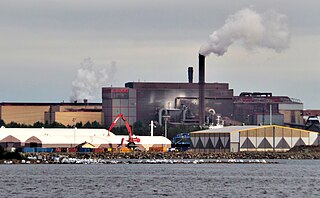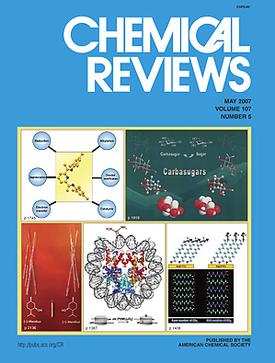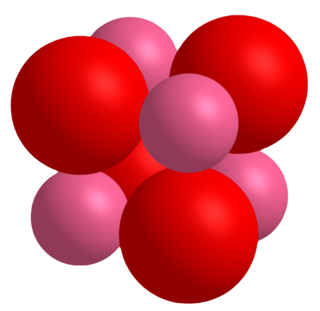
The American Chemical Society (ACS) is a scientific society based in the United States that supports scientific inquiry in the field of chemistry. Founded in 1876 at New York University, the ACS currently has more than 155,000 members at all degree levels and in all fields of chemistry, chemical engineering, and related fields. It is one of the world's largest scientific societies by membership. The ACS is a 501(c)(3) non-profit organization and holds a congressional charter under Title 36 of the United States Code. Its headquarters are located in Washington, D.C., and it has a large concentration of staff in Columbus, Ohio.

Environmental chemistry is the scientific study of the chemical and biochemical phenomena that occur in natural places. It should not be confused with green chemistry, which seeks to reduce potential pollution at its source. It can be defined as the study of the sources, reactions, transport, effects, and fates of chemical species in the air, soil, and water environments; and the effect of human activity and biological activity on these. Environmental chemistry is an interdisciplinary science that includes atmospheric, aquatic and soil chemistry, as well as heavily relying on analytical chemistry and being related to environmental and other areas of science.
Green chemistry, similar to sustainable chemistry or circular chemistry, is an area of chemistry and chemical engineering focused on the design of products and processes that minimize or eliminate the use and generation of hazardous substances. While environmental chemistry focuses on the effects of polluting chemicals on nature, green chemistry focuses on the environmental impact of chemistry, including lowering consumption of nonrenewable resources and technological approaches for preventing pollution.
Mathematical chemistry is the area of research engaged in novel applications of mathematics to chemistry; it concerns itself principally with the mathematical modeling of chemical phenomena. Mathematical chemistry has also sometimes been called computer chemistry, but should not be confused with computational chemistry.
The Royal Australian Chemical Institute (RACI) is both the qualifying body in Australia for professional chemists and a learned society promoting the science and practice of chemistry in all its branches. The RACI hosts conferences, seminars and workshops. It is the professional body for chemistry in Australia, with the ability to award the status of Chartered Chemist (CChem) to suitably qualified candidates.

Chemical Reviews is peer-reviewed scientific journal published twice per month by the American Chemical Society. It publishes review articles on all aspects of chemistry. It was established in 1924 by William Albert Noyes. The editor-in-chief is Sharon Hammes-Schiffer.
Physical Chemistry Chemical Physics is a weekly peer-reviewed scientific journal publishing research and review articles on any aspect of physical chemistry, chemical physics, and biophysical chemistry. It is published by the Royal Society of Chemistry on behalf of eighteen participating societies. The editor-in-chief is Anouk Rijs,.

Chemical Society Reviews is a biweekly peer-reviewed scientific journal published by the Royal Society of Chemistry, for review articles on topics of current interest in chemistry. Its predecessors were Quarterly Reviews, Chemical Society (1947–1971) and Royal Institute of Chemistry, Reviews (1968–1971); it maintained its current title since 1972. According to the Journal Citation Reports, the journal has a 2021 impact factor of 60.615. The current editor-in-chief is Jennifer Love.

Green Chemistry is a monthly peer-reviewed scientific journal covering every aspect of sustainable chemistry and its implementation in chemical engineering. It is published by the Royal Society of Chemistry and was established in 1999 by James Clark. Articles published in this journal are intended to be conceptually accessible to a wide audience. The editors-in-chief is Javier Pérez-Ramírez.

The Journal of Biological Chemistry (JBC) is a weekly peer-reviewed scientific journal that was established in 1905. Since 1925, it is published by the American Society for Biochemistry and Molecular Biology. It covers research in areas of biochemistry and molecular biology. The editor is Alex Toker. As of January 2021, the journal is fully open access. In press articles are available free on its website immediately after acceptance.

Quantities, Units and Symbols in Physical Chemistry, also known as the Green Book, is a compilation of terms and symbols widely used in the field of physical chemistry. It also includes a table of physical constants, tables listing the properties of elementary particles, chemical elements, and nuclides, and information about conversion factors that are commonly used in physical chemistry. The Green Book is published by the International Union of Pure and Applied Chemistry (IUPAC) and is based on published, citeable sources. Information in the Green Book is synthesized from recommendations made by IUPAC, the International Union of Pure and Applied Physics (IUPAP) and the International Organization for Standardization (ISO), including recommendations listed in the IUPAP Red Book Symbols, Units, Nomenclature and Fundamental Constants in Physics and in the ISO 31 standards.

Cobalt(II) oxide is an inorganic compound that has been described as an olive-green or gray solid. It is used extensively in the ceramics industry as an additive to create blue-colored glazes and enamels, as well as in the chemical industry for producing cobalt(II) salts. A related material is cobalt(II,III) oxide, a black solid with the formula Co3O4.

Philosophical Transactions of the Royal Society A: Mathematical, Physical and Engineering Sciences is a fortnightly peer-reviewed scientific journal published by the Royal Society. It publishes original research and review content in a wide range of physical scientific disciplines. Articles can be accessed online a few months prior to the printed journal. All articles become freely accessible two years after their publication date. The current editor-in-chief is John Dainton.
George Samuel Newth was an English chemist, best known for a series of popular chemistry books.
The International Union of Pure and Applied Chemistry (IUPAC) publishes many books which contain its complete list of definitions. The definitions are divided initially into seven IUPAC Colour Books: Gold, Green, Blue, Purple, Orange, White, and Red. There is also an eighth book, the "Silver Book".

Roger Arthur Sheldon is emeritus professor of Biocatalysis and Organic Chemistry at Delft University of Technology in the Netherlands.

ACS Sustainable Chemistry & Engineering is a weekly peer-reviewed scientific journal published by the American Chemical Society. It covers research in green chemistry, green engineering, biomass, alternative energy, and life cycle assessment. According to Journal Citation Reports, the journal has an impact factor of 8.4 in 2022. In 2023 Peter Licence was appointed Editor-in-Chief.
In organic chemistry, the Ferrario–Ackermann reaction or simply the Ferrario reaction is a name reaction that allow for the generation of phenoxanthiine from diphenyl ether and sulfur in the presence of aluminum chloride catalyst.










